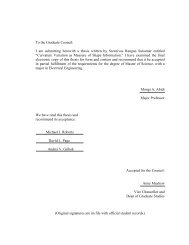Fusion of Visual and Thermal Face Recognition Techniques: A ...
Fusion of Visual and Thermal Face Recognition Techniques: A ...
Fusion of Visual and Thermal Face Recognition Techniques: A ...
You also want an ePaper? Increase the reach of your titles
YUMPU automatically turns print PDFs into web optimized ePapers that Google loves.
2.2 <strong>Fusion</strong> <strong>of</strong> <strong>Visual</strong> <strong>and</strong> <strong>Thermal</strong> Images<br />
With use <strong>of</strong> the database as shown in Table 1, we fused visual <strong>and</strong> thermal images.<br />
Ideally, the fusion <strong>of</strong> different sensors can be done by pixel-wise weighted summation <strong>of</strong><br />
visual <strong>and</strong> thermal images.<br />
F(x, y) = a(x, y)V(x, y) + b(x, y)T(x, y)<br />
(1)<br />
where F(x, y) is a fused output <strong>of</strong> a visual image, V(x, y) , <strong>and</strong> a thermal image, T(x, y) ,<br />
while a(x, y) <strong>and</strong> b(x, y) represent the weighting factor <strong>of</strong> each pixel. A fundamental<br />
problem is: which one has more weight at the pixel level. This can be answered if we<br />
know the illumination direction which affects the face in the visual images <strong>and</strong> other<br />
variations which affect the thermal images. Illumination changes in the visual images <strong>and</strong><br />
facial variations after exercise in the thermal images are also one <strong>of</strong> challenging problems<br />
in face recognition technology. Instead <strong>of</strong> finding each weight, we make use <strong>of</strong> the<br />
average <strong>of</strong> both modalities constraining both weighting factors a(x, y) , b(x, y) as 1.0. The<br />
average <strong>of</strong> visual <strong>and</strong> thermal images can compensate variations in each other, although<br />
this is not a perfect way to achieve data fusion. Figure 6(c) shows a fused image based on<br />
average intensity using (a) visual <strong>and</strong> (b) thermal images. We have produced the same<br />
number <strong>of</strong> fused images using datasets as described in Table.1. The fused output contains<br />
visual <strong>and</strong> thermal characteristics at the same time, thus, can be regarded to be more<br />
informative <strong>and</strong> synthetic than the original inputs.<br />
21
















